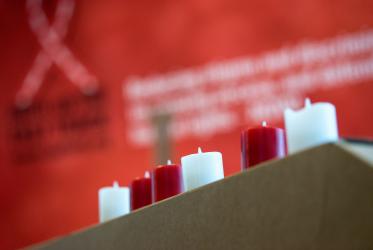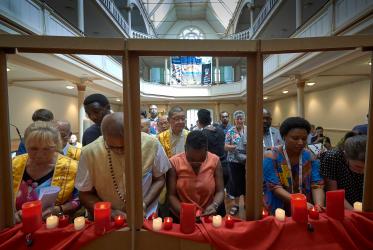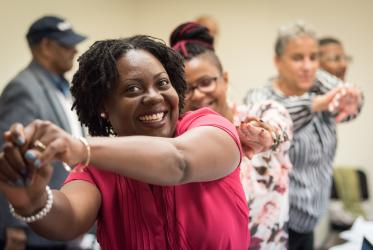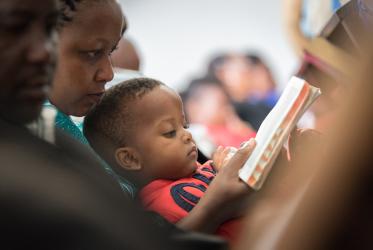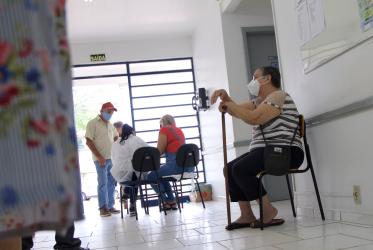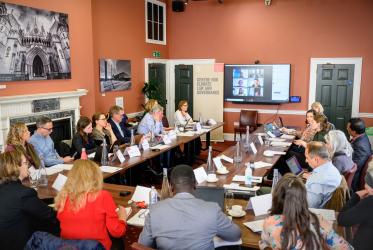To help the world’s children become HIV-free, faith groups must help bring UN goals to life through strong advocacy, rapid action and unprecedented collaboration, say experts.
Children must be helped onto a “Super Fast Track” to end AIDS or they will die at what Dr Stuart Kean describes as a “shocking” rate.
The term “Super Fast Track” is directly related to the UNAIDS “Fast Track” initiative to ensure, by 2020, 90 percent of those living with HIV know their status, 90 percent of those who know they are HIV-positive are receiving treatment, and 90 percent of those receiving treatment are on suppressed viral loads so they are no longer infectious.
“Super Fast Tracking” children does not diminish the Fast Track for adults, explained Kean, senior policy adviser on vulnerable children and HIV and AIDS for World Vision International. “It’s not that adults don’t need a Fast Track but, for children, it’s important to understand the shocking fact that 50 percent of babies and infants living with HIV will die by the age of two.”
And, he added, we are only managing to test and diagnose around 60 percent of the children whose mothers we know are living with HIV. “There are a lot of children we are not even diagnosing. Only half those children are even on treatment.”
The UNAIDS Super Fast Track calls for helping 1.6 million children receive treatment by 2018. “That’s two years from now,” Kean said, “and that’s doubling the number of children on treatment. We can’t do that without a Super Fast Track.”
Reaching this ambitious target is going to require superhuman efforts and unprecedented collaboration, acknowledged leaders from many sectors at the recent International AIDS Conference in Durban, South Africa.
UNAIDS, the U.S. President's Emergency Plan for AIDS Relief, the World Health Organization, UNICEF, Elizabeth Glaser Pediatric AIDS Foundation (EGPAF), Caritas Internationalis, the World Council of Churches Ecumenical Advocacy Alliance, and many other faith-based organizations have pledged to bring resources, expertise and a passion for justice to children who, they insist, deserve a voice in the fight against AIDS.
The voice of the faith community has been critical in establishing a Super Fast Track for children, said Chip Lyons, president and CEO of the EGPAF. “The Super Fast Track is a strategy of UNAIDS that has been improved and advanced, and made even more practical by virtue of the voices of the faith community,” he said. “The Political Declaration approved at the High Level Meeting six weeks ago, that draft document was not good enough for kids.”
But, he added, through “a lot of efforts form the faith community and others,” that document is now a better document for kids than any other political document approved by UN member states, demonstrating what collaboration across public, private and faith-based sectors can bring.
A lot of work, a little time
Even as they acknowledge success in helping to bring about a Super Fast Track initiative for children, faith-based groups and others acknowledged that they have a great deal of work to do in a limited amount of time.
Children need medications better suited to their needs, explained Monsignor Robert J. Vitillo, secretary general of the International Catholic Migration Commission. “Children’s bodies are not the same as adult bodies,” he said. “We are also lacking some of the needed formulations and dosages that are child-friendly.”
Faith-based groups have been collaborating and advocating with representatives from pharmaceutical companies and diagnostic companies to help explain the needs of children, since faith-based groups are often caregivers at a local level, where they see firsthand that lack of medication has a direct effect on children.
“No one sector of society can do this alone — not governments, not the UN, not faith-based organizations,” Vitillo added.
When conducting research and development, pharmaceutical companies start with adults, then move to adolescents, then move to young children, explained Astrid Berner-Rodoreda, HIV policy advisor for the German Protestant development agency Bread for the World. “But in this case the children are the ones who die very quickly.”
Some children are taking adult tablets that have been crushed — an unsafe though diminishing practice, she added. “But now you might have three different bottles of syrup for children, with three different doses. And some need to be refrigerated.”
That is not the ideal way for medication to be administered, she said, so pharmaceutical companies are working on developing dissolvable tablets that can be given with milk.
“On the medicine side, we’ve really seen a lot of progress in the last few years,” said Berner-Rodoreda. But diagnosing HIV in children needs significant improvement as well, she said. Tests are usually administered six weeks after babies are born, and mothers don’t always bring their babies back for testing. Then, if a child is tested, mothers have to come back to and get the results. “We need to work on tests that can be used straight after birth, then the child can be put into treatment straightaway. That would save a lot of lives.”
Faith-based groups also have a key role in reducing stigma surrounding HIV and AIDS, noted Kean. “One of the reasons why mothers don’t bring their babies back is because of stigma. They are quite likely to not come back, particularly if health staff are stigmatizing infants and mothers.”
Advocating for children not always easy
Isn’t saving the lives of children a universal priority? It seems so, but fading attention to HIV and AIDS could be disastrous for children, said Lyons. “The world is pretty rattled these days, whether it’s migration issues, or other disease outbreaks. But AIDS is not over. We have a historic public health opportunity in every country. We have to continue to push.”
Kean agreed that issues surrounding children often seem non-contentious since everyone wants what’s best for the kids. But, he noted, they are often forgotten. There was very little mention of children in the draft political document. “It was a result of advocacy that we brought great attention to children,” he said.
Watch video: Faith and the Super Fast Track for Children living with HIV - Informal press briefing at AIDS 2016
Coverage of faith-based issues and activities at AIDS 2016
Photos available for free download
Facebook: @Livethepromise
Twitter: #FaithAIDS2016
WCC-EAA Live the Promise: HIV Campaign
WCC Ecumenical HIV and AIDS Initiatives and Advocacy (EHAIA)



